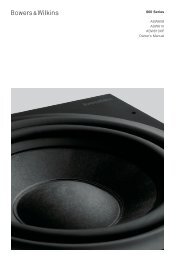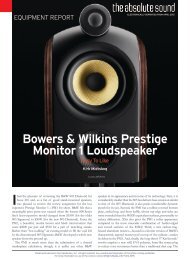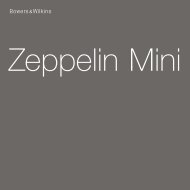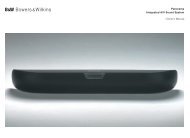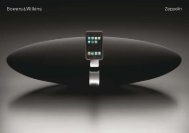CT8 XO Mk2 Manual - Bowers & Wilkins
CT8 XO Mk2 Manual - Bowers & Wilkins
CT8 XO Mk2 Manual - Bowers & Wilkins
You also want an ePaper? Increase the reach of your titles
YUMPU automatically turns print PDFs into web optimized ePapers that Google loves.
Helv 45, 7pt<br />
5, ing: 7pt 7 x 7 mm<br />
7 mm<br />
Helv 45, 7pt<br />
ing: 7 x 7 mm<br />
~40 o<br />
~120 o<br />
Figure 1<br />
Figure 1<br />
Figure 2 Figure 3<br />
Figure 2 Figure 3<br />
Figure 1<br />
Figure 2 Figure 3<br />
Figure<br />
Figure<br />
3<br />
4<br />
Figure 4<br />
Figure 4<br />
~40 o<br />
~40 o<br />
~40 o<br />
~120 o<br />
~120 o<br />
~120 o<br />
Check the contents against Figure 1<br />
Planning the Installation<br />
Planning the Installation<br />
Because of the built-in nature of the installation, the planning stage is of<br />
the utmost importance. Any need to adjust speaker position, for example,<br />
is a much more involved process than with free-standing speakers. Care<br />
must also be taken to construct proper support for the speakers. It is all<br />
too easy to induce the panels of custom furniture to vibrate and colour the<br />
sound unless precautions are taken to prevent it.<br />
Speaker Position<br />
Figures 2 to 4 show the recommended locations in plan view for the main<br />
speakers in 5.1, 6.1 and 7.1 channel installations. Some dimensions are<br />
Figure 5<br />
marked ~, indicating Figure that 5 there is some latitude allowed each side of the<br />
figure, and some have a recommended range for optimum results.<br />
Subwoofers should be placed close to the main speakers to which they<br />
are assigned.<br />
For successful operation of the surround speaker, <strong>CT8</strong> DS, in dipole<br />
Figure 7<br />
mode, it is important that all listeners sit within the speaker’s Figure 7 null zone.<br />
This is the 60° wide zone of low direct sound level created by the opposing<br />
polarity drivers on each side. You will notice from figures 3 and 4 that for<br />
6.1 and 7.1 systems, the side speakers are shown in line with the centre of<br />
the listening area. This is suitable regardless of whether these speakers<br />
are used in dipole or monopole mode. However, for 5.1 systems, the two<br />
surround speakers should be placed somewhat behind the listeners for<br />
effective results in monopole mode, or if you wish to switch between<br />
monopole and dipole modes for different types of programme. If you only<br />
ever intend to use them in dipole mode, the two surround speakers should<br />
revert to the in-line position. Please read the discussion on surround<br />
modes in the next section for a clearer understanding of the benefits of<br />
each type.<br />
For larger audience sizes, a more even coverage of the surround sound<br />
Figure 7<br />
field may be obtained Figure if7the surround speakers are elevated above ear<br />
height, as in a commercial cinema. In that case, the speakers may be<br />
raised so that the midrange/tweeter array is approximately 60cm (2 ft)<br />
above seated ear height.<br />
Figure 5<br />
Figure 5<br />
~60 o<br />
For correct operation of the <strong>CT8</strong> DS in dipole mode, it is important not to<br />
obstruct the side firing drivers. The speaker should be mounted with at<br />
least the front portion containing the side-firing drivers protruding into the<br />
room and any customised covering should be acoustically transparent.<br />
7<br />
Figure





